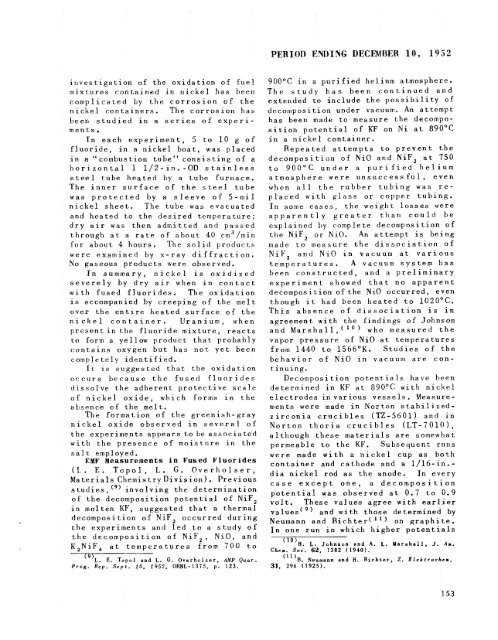the Molten Salt Energy Technologies Web Site
the Molten Salt Energy Technologies Web Site
the Molten Salt Energy Technologies Web Site
You also want an ePaper? Increase the reach of your titles
YUMPU automatically turns print PDFs into web optimized ePapers that Google loves.
investigation of <strong>the</strong> oxidation of fuel<br />
mixtures contained in nickel has been<br />
complicated by <strong>the</strong> corrosion of <strong>the</strong><br />
nickel containers. The corrosion has<br />
been studied in a series of experi-<br />
ments<br />
In each experiment, 5 to 10 g of<br />
fluoride, in a nickel boat, was placed<br />
in a “combustion tube” consisting of a<br />
horizontal 1 1/2-in.-OD stainless<br />
steel tube heated by a tube furnace.<br />
The inner surface of <strong>the</strong> steel tube<br />
was protected by a sleeve of 5 - m i l<br />
nickel sheet. The tube was evacuated<br />
and heated to <strong>the</strong> desired temperature;<br />
dry air was <strong>the</strong>n admitted and passed<br />
through at a rate of about 40 cm3/miri<br />
for about 4 hours. The solid product,s<br />
were examined by x-ray diffraction.<br />
No gaseous products were observed.<br />
In summary, nickel is oxidized<br />
severely by dry air when in contact<br />
with fused fluorides. The oxidation<br />
is accompanied by creeping of <strong>the</strong> melt<br />
over <strong>the</strong> entire heated surface of <strong>the</strong><br />
nickel container. Uranium, when<br />
present in <strong>the</strong> fluoride mixture, reacts<br />
to form a yellow product that probably<br />
contains oxygen but has not yet been<br />
completely identified.<br />
It 1s suggested that <strong>the</strong> oxidation<br />
orcurs because <strong>the</strong> fused fluorides<br />
d is so 1 ve <strong>the</strong> ad her en t p r o t e c t i ve s c a 1 e<br />
of nickel oxide, which forms in <strong>the</strong><br />
,.<br />
absence of <strong>the</strong> melt.<br />
1he formation of <strong>the</strong> greenish-gray<br />
nickel oxide observed in several of<br />
<strong>the</strong> experiments appears to be associated<br />
with <strong>the</strong> presence of moisture in <strong>the</strong><br />
salt employed.<br />
EMF Measurements in Fused Fluorides<br />
(L. E. Topol, L. G. Overholser,<br />
Materials ChemistryDivision). Previous<br />
studies, (’) involving <strong>the</strong> determination<br />
of <strong>the</strong> decomposition potential of NiF,<br />
in molten KF, suggested that a <strong>the</strong>rmal<br />
decomposition of NiF, occurred during<br />
<strong>the</strong> experiments and led to a study of<br />
<strong>the</strong> decomposition of NiF,, NiO, and<br />
K,?JiF, at temperatures from 700 to<br />
.__I<br />
(9)L. E. Topol and L. G. Overholser, ANP Quar.<br />
Prog. Rep. Sept. 10. 1952, ORNL-1375, p. 123.<br />
PERIOD EBBING DECEMBER 10, 1952<br />
900°C in a purified helium atmosphere.<br />
The study has been continued and<br />
extended to include <strong>the</strong> possibility of<br />
decomposition under vacuum. An attempt<br />
has been made to measure <strong>the</strong> decompo-<br />
sition potential of KF on Ki at 890°C<br />
in a nickel container.<br />
Repeated attempts to prevent <strong>the</strong><br />
decomposition of NiO and NiF, at 750<br />
to 900°C under a purified helium<br />
atmosphere were unsuccessful, even<br />
when all <strong>the</strong> rubber tubing was re-<br />
placed with glass or copper tubing.<br />
In some caseb, <strong>the</strong> weight losses were<br />
apparently greater than could be<br />
explained hy complete decomposition of<br />
<strong>the</strong> NiF, or hi0. An attempt is being<br />
made to measure <strong>the</strong> dissociation of<br />
NiF, and NiO in vacuum at various<br />
temperatures. A vacuum system has<br />
been constructed, and a preliminary<br />
experiment showed that no apparerlt<br />
decomposition of <strong>the</strong> NiO occurred, even<br />
though it had been heated to 1020°C.<br />
This absence of dissociation is in<br />
agreement with <strong>the</strong> findings of Johnson<br />
and Marshall,(’o) who measured <strong>the</strong><br />
vapor pressure of NiO at temperatures<br />
from 1440 to 1566°K. Studies of <strong>the</strong><br />
behavior of NiO in vacuurn are con-<br />
t inuing.<br />
Decomposition potentials have heen<br />
determined in KF at 890°C with nickel<br />
electrodes invarious vessels. Measure-<br />
ments were made in Norton stabilized-<br />
zirconia crucibles (TZ-5601) and in<br />
Norton thoria crucibles (LT-7010),<br />
although <strong>the</strong>se materials are somewhat<br />
permeable to <strong>the</strong> KF. Subsequent runs<br />
were made with a nickel cup as both<br />
container and cathode and a 1/16-in.-<br />
dia nickel rod as <strong>the</strong> anode. In every<br />
case except one, a decomposition<br />
potential was observed at 0.7 to 0.9<br />
volt. These values agree with earlier<br />
values(’) and wit,h those determined by<br />
Neumann and Richter( on graphite.<br />
In one run in which higher potentials<br />
(lo)H. L. Johnson and A. L. Marshall, J. Am.<br />
Chern. SOC. 62, 1382 (1940).<br />
(‘“B. Neurnann and H. Richter. Z. Elektrochem,<br />
31, 296 (1925).



![Review of Molten Salt Reactor Physics Calculations [Disc 2]](https://img.yumpu.com/21979492/1/190x247/review-of-molten-salt-reactor-physics-calculations-disc-2.jpg?quality=85)












